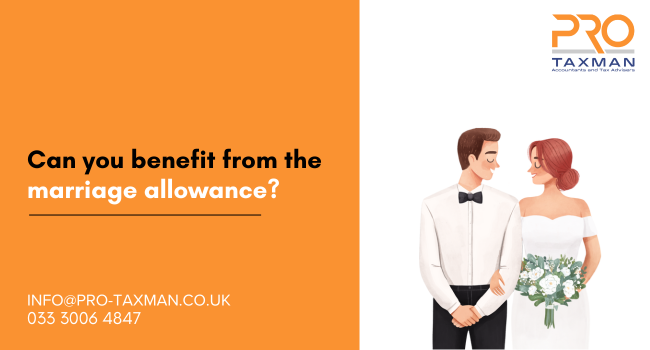The marriage allowance is not a separate allowance as such – rather, it is a transfer of part of one spouse or civil partner’s personal allowance to their spouse or civil partner. It should not be confused with the married couple’s allowance which is available where at least one spouse or civil partner was born before 6 April 1935.
The married couple’s allowance allows one spouse or civil partner to transfer 10% of their personal allowance (as rounded to the nearest £10) to their spouse or civil partner. However, the transfer is not permitted if the recipient pays tax at the higher or additional rate. For 2023/24 the personal allowance is £12,570 and the married couple allowance is £1,260.
Claiming the marriage allowance is beneficial if one spouse or civil partner is unable to use their personal allowance in full, and the other pays tax at the basic rate. Utilising the allowance can save a couple up to £252 in tax in 2023/24 (£1,260 @ 20%).
The only permitted transfer is £1,260 – it is not possible to transfer more of the personal allowance where this is unused or less if the amount unused is less than £1,260. However, if the unused personal allowance is less than £1,260 and making the transfer would mean that overall, the couple would pay less tax, it would be beneficial (although it may mean that some tax is now payable by the transferor).
Where the wedding allowance is claimed, the personal allowance of the spouse or civil partner making the transfer is reduced by £1,260 to £11,310, whereas the recipient’s personal allowance is increased to £13,830.
Older couples benefiting from the married couple’s allowance cannot also claim the marriage allowance.
Making a claim
A claim can be made online by visiting the Gov.uk website at www.gov.uk/apply-marriage-allowance. The claim can be made for the current tax year and also for 2019/20 and any later tax year for which the couple were eligible to make the claim. Once a claim has been made, it will apply for subsequent tax years until the claim is cancelled. This too can be done online.
Claims for the allowance can also be made through Self Assessment or by completing the married couple’s allowance form MATCF (see www.gov.uk/guidance/apply-for-marriage-allowance-by-post) and sending it to the address on the form.
Example 1
Alex and Anna are married. Alex earns £30,000 a year. Anna looks after their young daughter and has no income in 2023/24.
The couple claim the wedding allowance. As a result, Alex’s personal allowance is increased by £1,260, reducing the tax that he pays by £252.
Example 2
Jake and John are in a civil partnership. Jake works part-time while studying and earns £12,000 in 2023/24. John has income of £40,000 in 2023/24.
Jake is only able to use £12,000 of his personal allowance, leaving £570 unused. Although he cannot tailor the marriage allowance to transfer this to John, a claim is still worthwhile.
Making the claim will reduce Jake’s personal allowance by £1,260 to £11,310. As a result, he will now have to pay a small amount of tax as his income exceeds his reduced personal allowance by £690, generating a tax liability of £138 (£690 @ 20%).
However, John’s personal allowance will increase by £1,260, reducing the tax that he pays by £252.
Overall, despite the fact that Jake must now pay some tax, the couple’s combined tax bill is reduced by £114 (£252 − £138) as a result of claiming the allowance.
Need professional accounting service or tax advice? Contact us to book a 15-min Free Consultation with us today.
To find out more please follow us on Facebook, Twitter, or LinkedIn. Feel free to contact us on 0333 006 4847 or request a call back by texting 075 6464 7474

